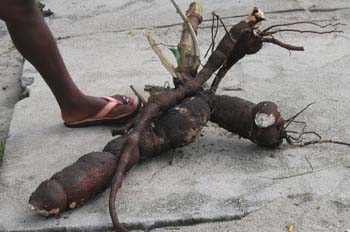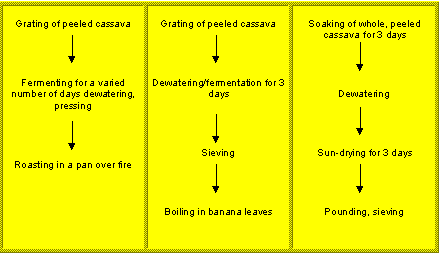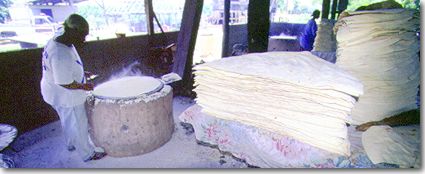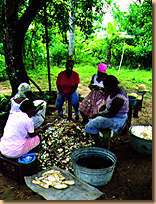Typical Cassava plant found in Cocal, Seine Bight Village (once upon a time)
In
Seine Bight and George Town, cassava is mostly grown on small farms, usually
intercropped with vegetables, plantation crops (such
as coconut,), yam, sweet potato,
melon, and corn. The
application of fertilizer remains limited among small-scale
farmers due to the high cost and lack of availability.
Roots can be harvested between 6 months and 3 years
after planting.
Cassava Production
The
major pests of cassava are the cassava green
mite, the cassava mealybug, and the variegated grasshopper known in Seine Bight as (Cha-ga-gown) .
The main diseases affecting cassava are cassava mosaic
disease, cassava bacterial blight, cassava anthracnose
disease, and root rot. Pests and diseases, together
with poor cultural practices, combine to cause yield
losses that may be as high as 50%. .
The
production of cassava is dependent on a supply of good
quality stem cuttings. The multiplication rate of these
vegetative planting materials is very low compared to
grain crops, which are propagated by true seeds. In
addition, cassava stem cuttings are bulky, and highly
perishable as they dry up within a few days.
As
a root crop, cassava requires considerable labor to
harvest. Because they are highly perishable, roots must
be processed into a storable form soon after harvest.
Many
cassava varieties contain cyanogenic glucosides, and
inadequate processing can lead to chronic toxicity.
Various processing methods, such as grating, sun drying,
and fermenting, are used to reduce the cyanide content.
Cassava is the most important tropical root crop. It’s starchy roots
are a major source of dietary energy for more than million of people worldwide.
It is known to be the highest producer of carbohydrates among staple crops.
According to United Nations Food and Agriculture Organization ´cassava
ranks fourth of food crops in the developing countries after rice, maize
and wheat. The leaves are relatively rich on protein and can be consumed.
Cassava can be stored in the ground for several seasons, thereby serve
as a reserve food when other crops fail. Cassava is also increasingly used
for animal feed and in different industrial processes and products. A problem
with cassava is the poisonous cyanides which have to be disarmed before
consumption. Cassava is called "Manioc" in Francophone areas
and Tapioca in Latin America. Portuguese name it "Mandioca" and
Spanish "Yucca".
Adherence to an appropriate and efficient processing method for cassava
roots is the essential measures to avoid toxic effects. If the root is
eaten without processing it to remove all the cyanoglucosides than chronic
cyanide poisoning, and even paralysis may result.
Seine Bight, Hopkins & George Town Villages Process Yuca -to- Cassava
for food uses - Benjamin E. Palacio

Once harvested, yuca decomposes fairly quickly, such that it must be eaten or prepared straight away. Although many varieties can be eaten raw or cooked like potatoes, many types contain high levels of cyanotic sugars that must be eliminated before the yuca is digestible. Customarily the toxins are eliminated from these bitter varieties through a process of first pealing and grating the root to obtain a pulp. The pulp is left to ferment slightly before being squeezed dry and toasted. This toasted bread, called casava, is prepared without yeast.
A nutritional analysis shows that casaba EREBA is a very healthy product and can be served as a base for any diet. Since it has a low percentage of fat, casaba is an excellent accompaniment for all types of food and can be used as a substitute for potatoes, rice, tortillas and plantains.


Since it is recognized that the Garifuna are meshed together with influences
from many different cultures; it is also possibly in some degree to begin
to separate parts of their culture to determine their roots. One
example of this is their Amerindian influences of the Arawaks and Caribs
collectively known as the Island Caribs. When the African slaves intermixed
with the Island Caribs they brought into the culture many African based
influences that have been previously discussed. However, in order to better
understand whom the Garifuna are it becomes necessary to relate other adopted
characteristics of their culture to they're other major ancestral influence,
the Island Caribs. This Island Carib culture was one that was founded on
yucca and cassava farming as well as hunting and fishing sometime before
1000AD(Garinagu Early History, 1). It is quite amazing then that
the Garifuna women are still widely known for their tradition of making
cassava bread (Palacio 1993,1-3). In addition, the Garifuna men have
always been known for their maritime skills since they were mainly away
hunting and fishing from various islands throughout the Caribbean and Central
America (Global Neighbors: Garifuna History, 1). It is not hard to understand
then why the Garifuna are both a matrilocal.


